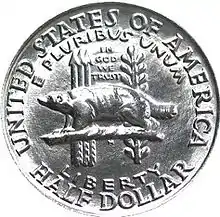Wisconsin Territorial Centennial half dollar
The Wisconsin Territorial Centennial half dollar was designed by David Parsons and Benjamin Hawkins and minted in 1936. The obverse depicts a badger and the territorial seal, while the reverse shows a pick axe and lead ore.[1]
United States | |
| Value | 50 cents (0.50 US dollars) |
|---|---|
| Mass | 12.5 g |
| Diameter | 30.61 mm |
| Thickness | 2.15 mm (0.08 in) |
| Edge | Reeded |
| Composition |
|
| Silver | 0.36169 troy oz |
| Years of minting | 1936 |
| Mintage | 25,015 (a minimum of 25,000 coins was authorized) |
| Mint marks | None, all pieces struck at the Philadelphia Mint without mint mark |
| Obverse | |
 | |
| Design | Arm holding pickax with lead ore |
| Designer | David Parsons and Benjamin Hawkins |
| Design date | 1936 |
| Reverse | |
 | |
| Design | Badger, three arrows, and an olive branch |
| Designer | David Parsons and Benjamin Hawkins |
| Design date | 1936 |
Background
Wisconsin, before being admitted into the Union as a state in 1848, was originally a territory. Before that, much of the Wisconsin Territory had been part of Northwest Territory, ceded by Great Britain in 1783 as part of the Treaty of Paris. Then part of the Michigan Territory, the area of what would become the Wisconsin Territory gained importance during the 1820s, when large deposits of lead (commemorated on the obverse of the coin) were discovered in southwestern Wisconsin. As more Americans moved into the area, the territory became important enough to become a separate territory in 1836.[2]
Inception
1936 was a peak year for commemorative coins, as numerous commemoratives were approved and struck commemorating events such as the Cleveland Centennial, the Elgin Centennial, and the Albany Charter. In order to help fund various activities for the Wisconsin Centennial that year, the Wisconsin Centennial Commission appointed a Coinage Committee to call for commemorative half dollar commemorating the Centennial. When the bill passed on May 15, 1936, it also authorized two other commemorative coins marking the centennial of Bridgeport, Connecticut, and the tercentenary of Swedish settlement in Delaware. As 1936 was the peak year for commemorative coins, the fact that all three coins were hardly worthy of commemoration on United States coinage due to being of local or regional significance was not taken into consideration.[2]
Preparation
David Parsons, a young university art student, was recruited by Wisconsin's Coinage Committee to prepare models for the coin. However, as the models were in very high relief, they were rejected by the United States Mint. When the Mint was asked by the committee for a sculptor that would serve as Parsons's replacement, the Mint subsequently referred the issue to the Commission of Fine Arts, which then recruited New York sculptor Benjamin Hawkins. Despite being given only three weeks to complete his models, Hawkins submitted the refined models to the Mint on June 3, 1936, which were approved by Commission of Fine Arts two days later.[2]
Release
While the legislation authorizing the commemorative called for a minimum mintage of 25,000 coins with no limit on the maximum number of coins that could be minted, the commission chose to take a conservative approach and only minted 25,015 coins. Although the coins were unlikely to have been available during the Wisconsin Centennial celebration from June 27 to July 5, most were sold for $1.50 per coin by mail order through the work of the committee, which had been advertising the coins since April, before either the legislation authorizing the coins or even the design of the coin had come about.[2] However, due to their late release and primarily local appeal, the coins did not sell very well, and many remained unsold by the end of the year. They continued to be sold for the following 16 years at the reduced price of $1.25 per coin, until the price was raised to $3 per coin in 1952.[2] The supply of coins eventually was exhausted in the late 1950s.[1]
The coins were sold in plain cardboard holders that, similar to holders for the York County, Maine Tercentenary half dollar, contained slots for up to five coins. Orders of one or two coins were sealed in tissue paper and shipped in envelopes that were either imprinted "L.M. HANKS, FIRST NATIONAL BANK BUILDING, MADISON, WISC". or rubber-stamped "AFTER 10 DAYS RETURN TO STATE SUPERINTENDENT, STATE CAPITOL, MADISON, WISC." Like the coins, envelopes are collectibles.
See also
- Early United States commemorative coins
- Half dollar (United States coin)
References
- "1936 Wisconsin 50C MS Silver Commemoratives". www.ngccoin.com. Retrieved 10 April 2019.
- "Wisconsin Centennial Half Dollar - CoinSite". Retrieved 10 April 2019.
External links
 Media related to Wisconsin Territorial Centennial half dollar at Wikimedia Commons
Media related to Wisconsin Territorial Centennial half dollar at Wikimedia Commons